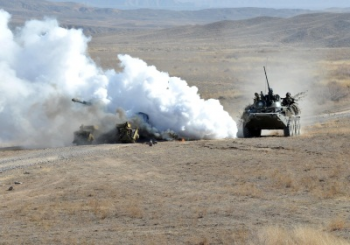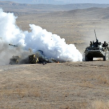
Kazakhstan and Russia Complete “Aldaspan-2012” Military Exercises
Publication: Eurasia Daily Monitor Volume: 9 Issue: 139
By:

From July 7 to July 12, Russia and Kazakhstan held their latest joint military exercise, “Aldaspan-2012.” Although Kazakhstan’s security priorities lie in countering terrorists, insurgents, and other small groups of armed militants, Russia’s concern about fighting large-scale mass uprisings, as in Chechnya, or fighting major conventional wars with regional opponents often shape the exercise agenda.
In this case, the three-stage Aldaspan-2012 focused on practicing the tactical and operational skills useful for fighting small groups of terrorists. The scenario consisted of an armed band that had established a mountain stronghold and was destabilizing the surrounding region. The first two phases involved meetings of a joint bi-national staff to create and deploy the combined Kazakhstani-Russian force. In the third active stage, the joint force first established road blocks and other posts to contain the militants, and then attacked them with combat and transport helicopters and other support provided by the Army Aviation of Air Defense Forces of Kazakhstan (KZinform, July 4).
Some three thousand soldiers participated in the exercise. The Kazakhstani contingents belonged to the airmobile and air defense forces of the “Yug” (“South”) command, including the 35th air assault brigade of Kazakhstan’s airborne troops. Troops from Kazakhstan’s Ministry of the Interior, Ministry of Emergency Situations and the Border Guard Service also participated.
Russia was represented by a task force from the Russian Federation’s Central Military District (Caspionet, July 4). An air assault brigade of airborne troops landed along with BMD-2 combat vehicles flown from Ulyanovsk. The Russian Air Force provided Il-76 military transport aircraft and Mi-8 multi-purpose helicopters. Planes from Russia’s Kant airbase in the Kyrgyz Republic joined Kazakhstani planes in providing them air support.
The Russian contingent was led by Colonel Kornelia Babia, deputy commander of the 41st Army, who said these drills aimed to improve combat skills and interoperability between Russian and Kazakhstani forces (Trend, July 9). Kazakhstani Lieutenant-General Murat Maikeev was the overall exercise commander (Ministry of Defense of Kazakhstan, July 9). Kazakhstani Defense Minister Adilbek Dzhaksybekov observed part of the exercise (Kazpravda, July 17).
The drills occurred in the Almaty region in southeastern Kazakhstan. The Koktal firing range there is one of Kazakhstan’s few training facilities located in mountainous terrain. The skills practiced included conducting reconnaissance in a threatened area; organizing a system of roadblocks at key points such as bridges, mountain passes, and highway nodes; and arranging for the mass movement of forces under cover of night.
At the official opening ceremony on July 9, Murat Maikeev, the Commander-in-Chief of the Land Force of Kazakhstan, welcomed the participants, telling them that “we have one task with you during all the exercises – to strengthen military cooperation in order to preserve peace and stability in our region” (Ministry of Defense of Kazakhstan, July 9).
Russian and Kazakhstani forces had participated in a similar joint exercise in 2008. The first “Aldaspan” (which means “sword” in the Kazakh language) drill also involved Kazakhstan’s “South” command and its elite airborne troops. The Russian Ministry of Defense sent combat aircraft and special forces to the drill (ITAR-TASS, July 7, 2007).
Despite Kazakhstan’s “multi-vectored” approach to foreign policy, Moscow is clearly Astana’s premier partner in the defense and security sector. These close ties result from their shared military heritage, culture, perceived threat as well as their geographic proximity, shared alliances, and similar military doctrine, strategy and tactics. Former Defense Minister Daniyal Akhmetov openly stated that, “Russia’s armed forces are the main strategic ally of the Kazakh armed forces” (Interfax-Kazakhstan, Almaty, May 12, 2008).
Perhaps the most visible military manifestation of this cooperation is in their joint exercises, which occur through both bilateral and multilateral mechanisms. The latter include the Shanghai Cooperation Organization (SCO) and especially the Collective Security Treaty Organization (CSTO). Kazakhstan makes the largest military contribution to the CSTO after Russia, and the two countries have become the main drivers of recent efforts to strengthen that organization by giving it new missions and capabilities.
An earlier Center 2008 military exercise at the Chebarkul training range involved approximately 2,000 soldiers, 100 armored vehicles, and 30 planes and helicopters, making it the largest joint military exercise between Russia and Kazakhstan since the fall of the Soviet Union.
The Center 2011 exercise, in the Mangystau region near Aktau, was even larger. The Kazakhstani units involved included a marine brigade, Mi-24 helicopters and other aviation units, warships and hundreds of other weapons systems. The scenario had Russia support Kazakhstan against an attack from the Caspian Sea (see EMD, September 28, 2011).
Russia’s influence on the development of the Kazakhstani armed forces manifests itself in the focus of these exercises on repelling attacks from foreign countries. In fact, Kazakhstan’s main security threats emanate from terrorists, such as small mobile groups of religious extremists in Kazakhstan, and even more from non-military environmental and socioeconomic developmental challenges. But the Moscow-led alliance network in Central Asia is preoccupied with external conventional threats, with Iran typically filling in as the appropriate force-sizing metric.




